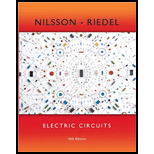Browse All Chapters of This Textbook
Book Details
Electric Circuits, Tenth Edition, is designed for use in a one or two-semester Introductory Circuit Analysis or Circuit Theory Course taught in Electrical or Computer Engineering Departments. This title is also suitable for readers seeking an introduction to electric circuits.
Electric Circuits is the most widely used introductory circuits textbook of the past 25 years. As this book has evolved to meet the changing learning styles of students, the underlying teaching approaches and philosophies remain unchanged.
MasteringEngineering for Electric Circuits is a total learning package that is designed to improve results through personalized learning. This innovative online program emulates the instructor's office-hour environment, guiding students through engineering concepts from Electric Circuits with self-paced individualized coaching.
Teaching and Learning Experience
This program will provide a better teaching and learning experience - for you and your students.
- Personalize Learning with Individualized Coaching: MasteringEngineering provides students with wrong-answer specific feedback and hints as they work through tutorial homework problems.
- Emphasize the Relationship between Conceptual Understanding and Problem Solving Approaches: Chapter Problems and Practical Perspectives illustrate how the generalized techniques presented in a first-year circuit analysis course relate to problems faced by practicing engineers.
- Build an Understanding of Concepts and Ideas Explicitly in Terms of Previous Learning: Assessment Problems and Fundamental Equations and Concepts help students focus on the key principles in electric circuits.
- Provide Students with a Strong Foundation of Engineering Practices: Computer tools, examples, and supplementary workbooks assist students in the learning process.
Sample Solutions for this Textbook
We offer sample solutions for Electrical Circuits and Modified MasteringEngineering - With Access homework problems. See examples below:
More Editions of This Book
Corresponding editions of this textbook are also available below:
